Physical Address
304 North Cardinal St.
Dorchester Center, MA 02124
Congenital malformations have attracted attention since the dawn of human history. When seen in humans or animals, malformations were often interpreted as omens of good or evil. Because of the great significance attached to congenital malformations, they were frequently represented in folk art as sculptures or paintings. As far back as the classical Greek period, people speculated that maternal impressions during pregnancy (e.g., being frightened by an animal) caused development to go awry. In other cultures, women who gave birth to malformed infants were assumed to have had dealings with the devil or other evil spirits.
Early representations of some malformed infants are remarkable in their anatomical accuracy, and it is often possible to diagnose specific conditions or syndromes from the ancient art ( Figure 8.1 ). By the Middle Ages, however, representations of malformations were much more imaginative, with hybrids of humans and other animals often depicted ( Figure 8.1B ).
Among the first applications of scientific thought to the problem of congenital malformations were those of the sixteenth-century French surgeon Ambrose Paré, who suggested a role for hereditary factors and mechanical influences such as intrauterine compression in the genesis of birth defects. Less than a century later, William Harvey, who is also credited with first describing the circulation of blood, elaborated the concept of developmental arrest and further refined thinking on mechanical causes of birth defects.
In the early nineteenth century, Etienne Geoffroy de St. Hilaire coined the term teratology , which literally means “the study of monsters,” as a descriptor for the newly emerging study of congenital malformations. Late in the nineteenth century, scientific study of teratology was put on a firm foundation with the publication of several encyclopedic treatises that exhaustively covered anatomical aspects of recognized congenital malformations.
After the flowering of experimental embryology and genetics in the early twentieth century, laboratory researchers began to produce specific recognizable congenital anomalies by means of defined experimental genetic or laboratory manipulations on laboratory animals. This work led to the demystification of congenital anomalies and to a search for rational scientific explanations for birth defects. Nevertheless, old beliefs are tenacious, and even today patients may adhere to traditional beliefs.
The first of two major milestones in human teratology occurred in 1941, when Gregg in Australia recognized that the rubella virus was a cause of a recognizable syndrome of abnormal development, consisting of defects in the eyes, ears, and heart. Approximately 20 years later, the effects of thalidomide sensitized the medical community to the potential danger of certain drugs and other environmental teratogens (agents that produce birth defects) to the developing embryo.
Thalidomide is a very effective sedative that was widely used in West Germany, Australia, and other countries during the late 1950s. Soon, physicians began to see infants born with extremely rare birth defects. More than 10,000 infants with severe thalidomide-induced birth defects were reported. The classic defect is phocomelia (which means “seal limb”), a condition in which the hands and feet seem to arise almost directly from the shoulder and hip ( Figure 8.2 ). Another is amelia , in which a limb is entirely missing. Thalidomide was identified as the certain cause after careful epidemiological detective work involving the collection of individual case reports and sorting of the drugs taken by mothers during the early period of their pregnancies. Thalidomide is still a drug of choice in the treatment of leprosy and multiple myeloma. The means by which thalidomide produces congenital malformations remains incompletely understood, but it is known to be antiangiogenic, acting through the degradation of SALL4, a transcription factor important in a number of developing systems. Vascular collapse in the developing limb may account for the reduction in proximal elements of the limb. With the intense investigations that followed the thalidomide disaster, modern teratology came of age. Despite much effort, however, the causes of most congenital malformations are still unknown.
A healthy outcome occurs less than 50% of the time for all fertilized eggs ( Figure 8.3 ). The remainder involves a variety of pathological events ranging from early embryo loss to preterm births to congenital malformations.
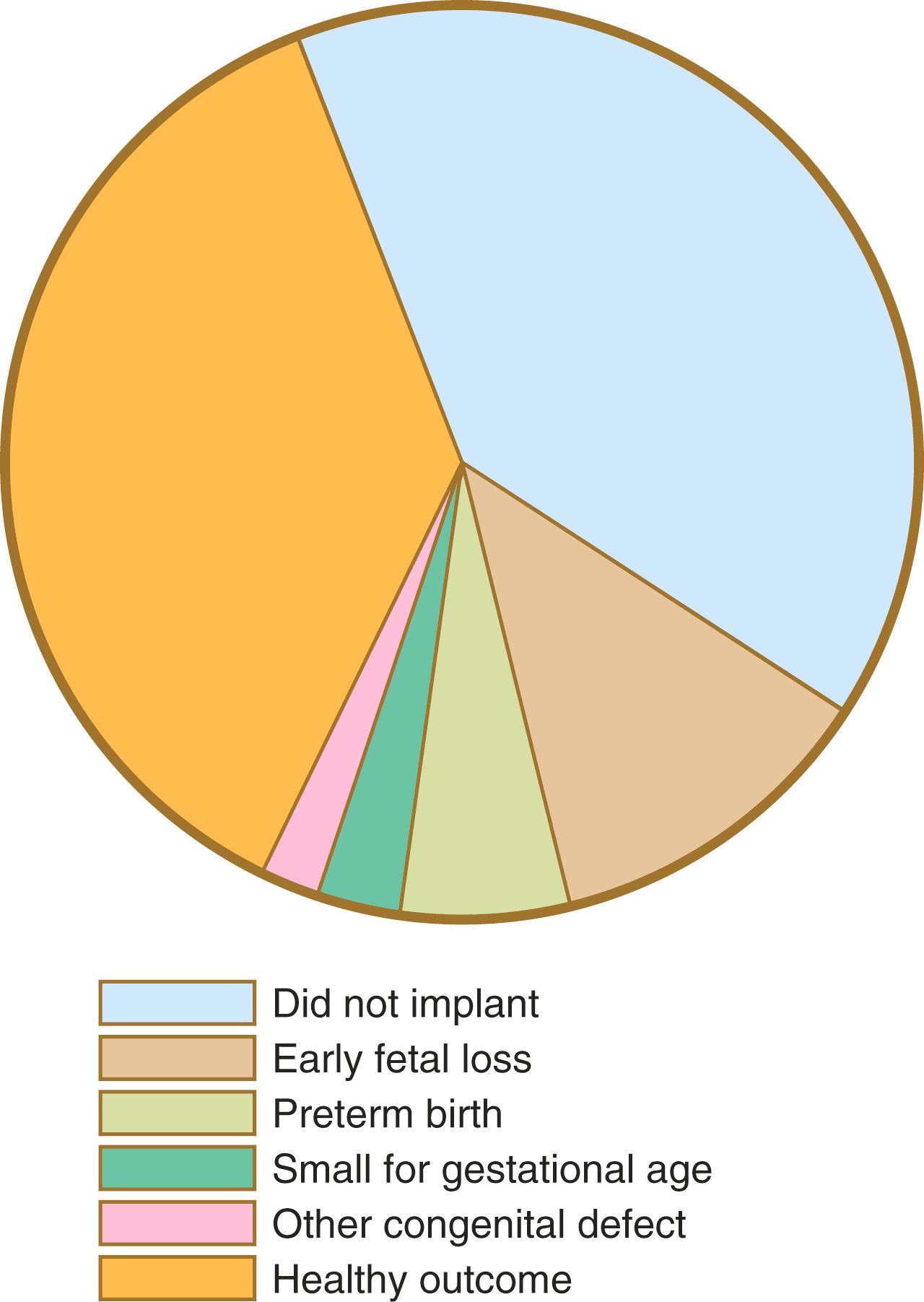
According to most studies, approximately 2% to 3% of all living newborns show at least one recognizable congenital malformation. This percentage is doubled when one considers anomalies diagnosed in children during the first few years after birth. With the decline in infant mortality caused by infectious diseases and nutritional problems, congenital malformations now rank high among the causes of infant mortality (currently >20%) and increasing percentages (≤30%) of infants admitted to neonatology or pediatric units result from various forms of genetic diseases or congenital defects.
Congenital defects range from enzyme deficiencies caused by single nucleotide substitutions in the DNA molecule to very complex associations of gross anatomical abnormalities. Although medical embryology textbooks traditionally cover principally structural defects—congenital malformations—a continuum exists between purely biochemical abnormalities and defects that are manifested as abnormal structures. This continuum includes defects that constitute abnormal structure, function, metabolism, and behavior.
Birth defects appear in a variety of forms and associations, ranging from simple abnormalities of a single structure to often grotesque deformities that may affect an entire body region. Some of the common classes of malformations are listed in Table 8.1 .
| Abnormalities of Individual Structures | |
| Malformation | A structural defect of part of or an entire organ or larger part of a body region that is caused by an abnormal process intrinsic to its development (e.g., coloboma) (see p. 289) |
| Disruption | A defect in an organ or body part caused by process that interferes with an originally normal developmental process (e.g., thalidomide-induced phocomelia) (see p. 136) |
| Deformation | A structural abnormality caused by mechanical forces (e.g., amniotic band constriction) (see Figure 8.19 ) |
| Dysplasia | An abnormality of a tissue caused by an abnormal intrinsic developmental process (e.g., ectodermal dysplasia) (see p. 165) |
| Defects Involving More Than One Structure | |
| Sequence | A pattern of multiple malformations stemming from a disturbance of a prior developmental process or mechanical factor (e.g., Potter sequence) (see p. 394) |
| Syndrome | A group of malformations of different structures because of a single primary cause, but acting through multiple developmental pathways (e.g., trisomy 13 syndrome) (see Figure 8.12 ) |
| Association | A group of anomalies seen in more than one individual that cannot yet be attributed to a definitive cause |
The genesis of congenital defects can be viewed as an interaction between the genetic endowment of the embryo and the environment in which it develops. The basic information is encoded in the genes, but while the genetic instructions unfold, the developing structures or organs are subjected to microenvironmental or macroenvironmental influences that either are compatible with or interfere with normal development. In the case of genetically based malformations or anomalies based on chromosomal aberrations, the defect is intrinsic and is commonly expressed even in a normal environment. Purely environmental causes can interfere with embryological processes in the face of a normal genotype. In other cases, environment and genetics interact. Penetrance (the degree of manifestation) of an abnormal gene or expression of one component of a genetically multifactorial cascade can sometimes be profoundly affected by environmental conditions.
Studies on mice have identified many genes that, if defective, are responsible for some sort of developmental disturbance or set of disturbances, which is then called a syndrome . Some of these defects are purely mutational, residing in the structure of the DNA itself, whereas others result from interference in transcription or translation or from regulatory elements of the gene. In humans, single gene defects may account for as many as 2400 separate malformations or syndromes.
In contrast to syndromes, where seemingly disconnected anomalies can be traced to a common genetic cause, an association consists of a group of seemingly unrelated anomalies that co-occur, but without a genetic connecting link. A good example of an association is VACTERL , which consists of vertebral, anal, cardiac, tracheo-esophageal, and renal and limb defects. In these cases, the link remains to be discovered.
Several factors are associated with various types of congenital malformations. At present, they are understood more at the level of statistical associations than as points of interference with specific developmental controls, but they are important clues to why development can go wrong. Among the factors associated with increased incidences of congenital malformations are (1) parental age; (2) season of the year; (3) country of residence; (4) race; and (5) familial tendencies.
Well-known correlations exist between parental age and the incidence of certain malformations. A classic correlation is the increased incidence of Down syndrome ( Figure 8.4 ; see Figure 8.11 ) in children born to women older than 35 years of age. Other conditions are related to paternal age (see Figure 8.4 ).
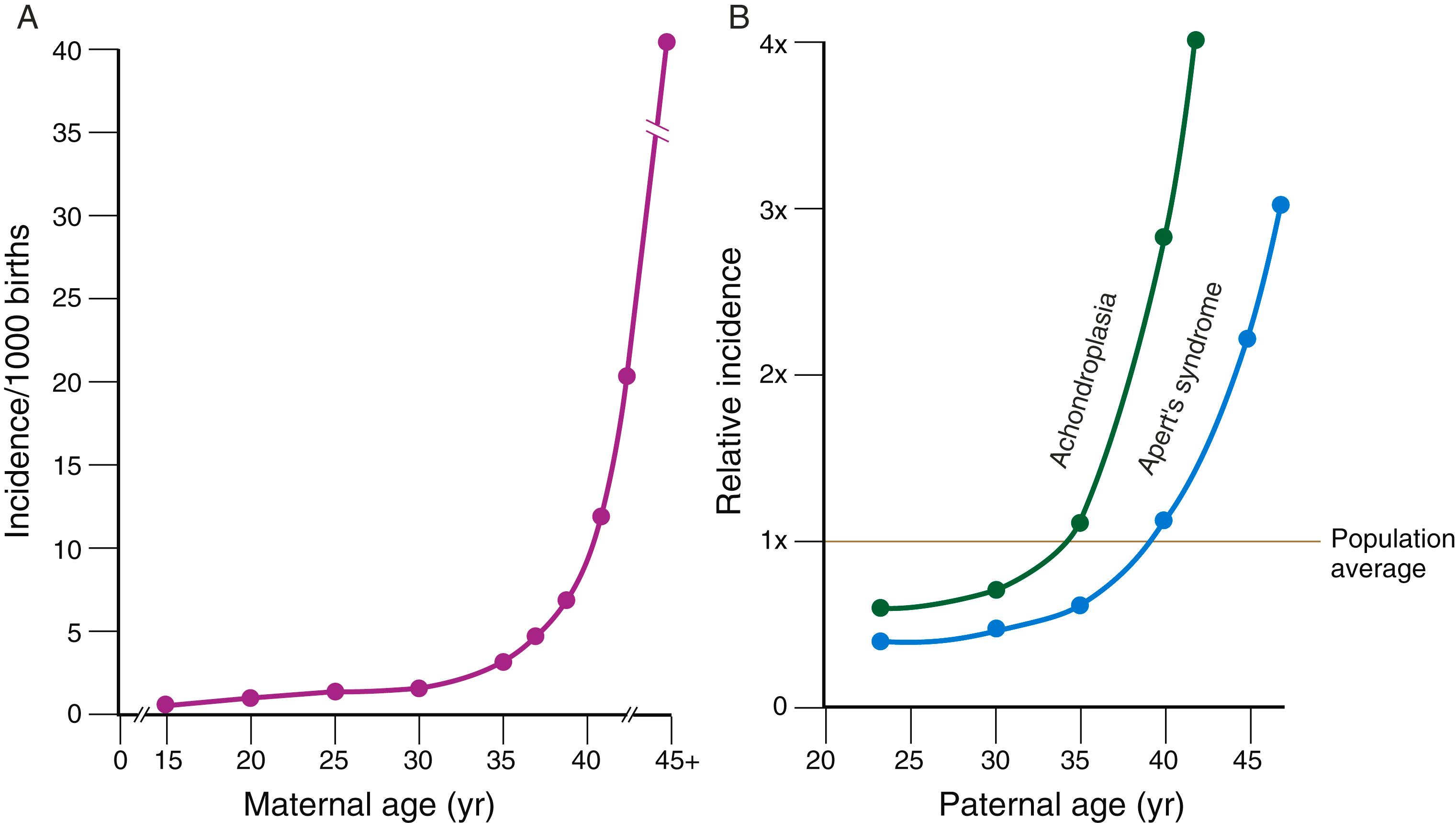
Some types of anomalies have a higher incidence among infants born in certain seasons of the year. Anencephaly ( Figure 8.5 ) occurs most frequently in January. Recognizing that the primary factors leading to anencephaly occur during the first month of embryonic life, researchers must seek the potential environmental causes that are more prevalent in April. Anencephaly has been shown to be highly correlated with maternal folic acid deficiency . The high incidence of this anomaly in pregnancies beginning in the early spring may be associated with nutritional deficiencies of mothers during the late winter months. Folic acid supplementation in the diet of women of childbearing age significantly reduces the incidence of neural tube defects, such as anencephaly. Historically, neural tube defects were very common in Ireland (see Table 8.2 ), but a greater than threefold decrease in the incidence of neural tube defects in Ireland from 1980 to 1994 may be connected to both better nutrition and folic acid supplementation by a certain percentage of pregnant women.
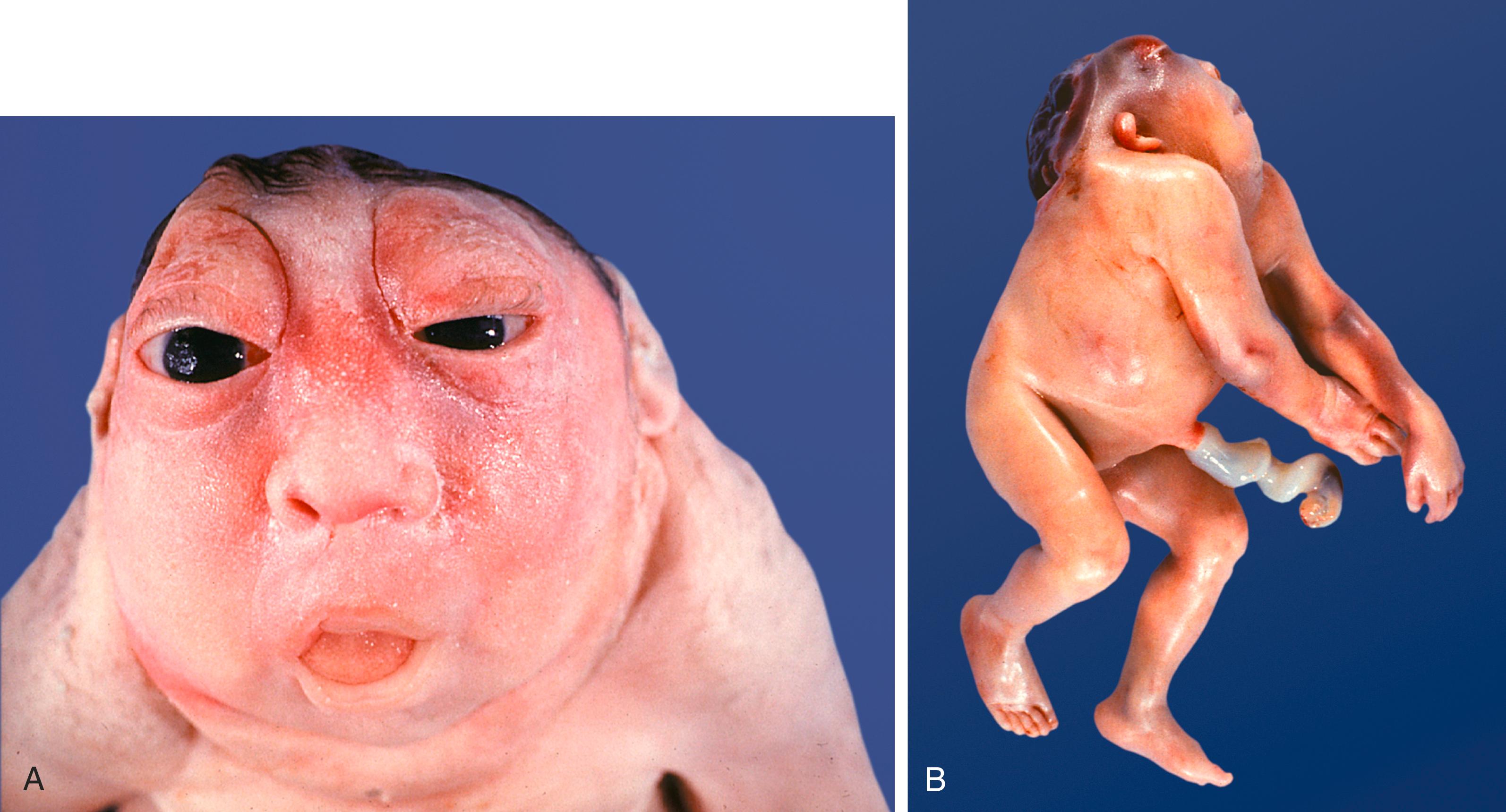
The relationship between the country of residence and an increased incidence of specific malformations can be related to various factors, including racial tendencies, local environmental factors, and even governmental policies. A classic example of the last is the incidence of severely malformed infants as a result of exposure to thalidomide. These cases were concentrated in West Germany and Australia because the drug was commonly sold in these locations. Because thalidomide was not approved by the Food and Drug Administration, the United States was spared from this epidemic of birth defects. Another classic example of the influence of country as a factor in the incidence of malformations is seen in neural tube defects ( Table 8.2 ). The reason neural tube defects (especially anencephaly) were so common in Ireland has been the topic of much speculation, but poor nutrition during the late winter is a likely cause.
Race is a factor in many congenital malformations and a variety of diseases. In humans and mice, there are racial differences in the incidence of cleft palate. The incidence of cleft palate among whites is twice as high as it is among blacks and twice as high among Korean, Chinese, and Japanese persons as among whites.
Many malformations, particularly those with a genetic basis, are found more frequently within certain families, especially if there is any degree of consanguinity in the marriages over the generations. A good example is the increased occurrence of extra digits among some families within the Amish community in the United States.
At certain critical periods during pregnancy, embryos are more susceptible to agents or factors causing abnormal development than at other times. The results of many investigations have allowed the following generalization: insults to the embryo during the first 3 weeks of embryogenesis (the early period before organogenesis begins) are unlikely to result in defective development because they either kill the embryo or are compensated for by the powerful regulatory properties of the early embryo. The period of maximal susceptibility to abnormal development occurs between weeks 3 and 8, the period when most of the major organs and body regions are first established.
Major structural anomalies are unlikely to occur after the eighth week of pregnancy because by this point most organs are well established. Anomalies arising from the third to the ninth month of pregnancy tend to be functional (e.g., mental retardation) or involve disturbances in the growth of already formed body parts. Such a simplified view of susceptible periods does not account, however, for the possibility that a teratogen or some other harmful influence may be applied at an early stage of development but not expressed as a developmental disturbance until later during embryogenesis. Certain other influences (e.g., intrauterine diseases, toxins) may result in the destruction of all or parts of structures that have already been formed.
Typically, a developing organ has a curve of susceptibility to teratogenic influences similar to that illustrated in Figure 8.6 . Before the critical period, exposure to a known teratogen has little influence on development. During the first days of the critical period, the susceptibility, measured as incidence or severity of malformation, increases sharply and then declines over a much longer period.
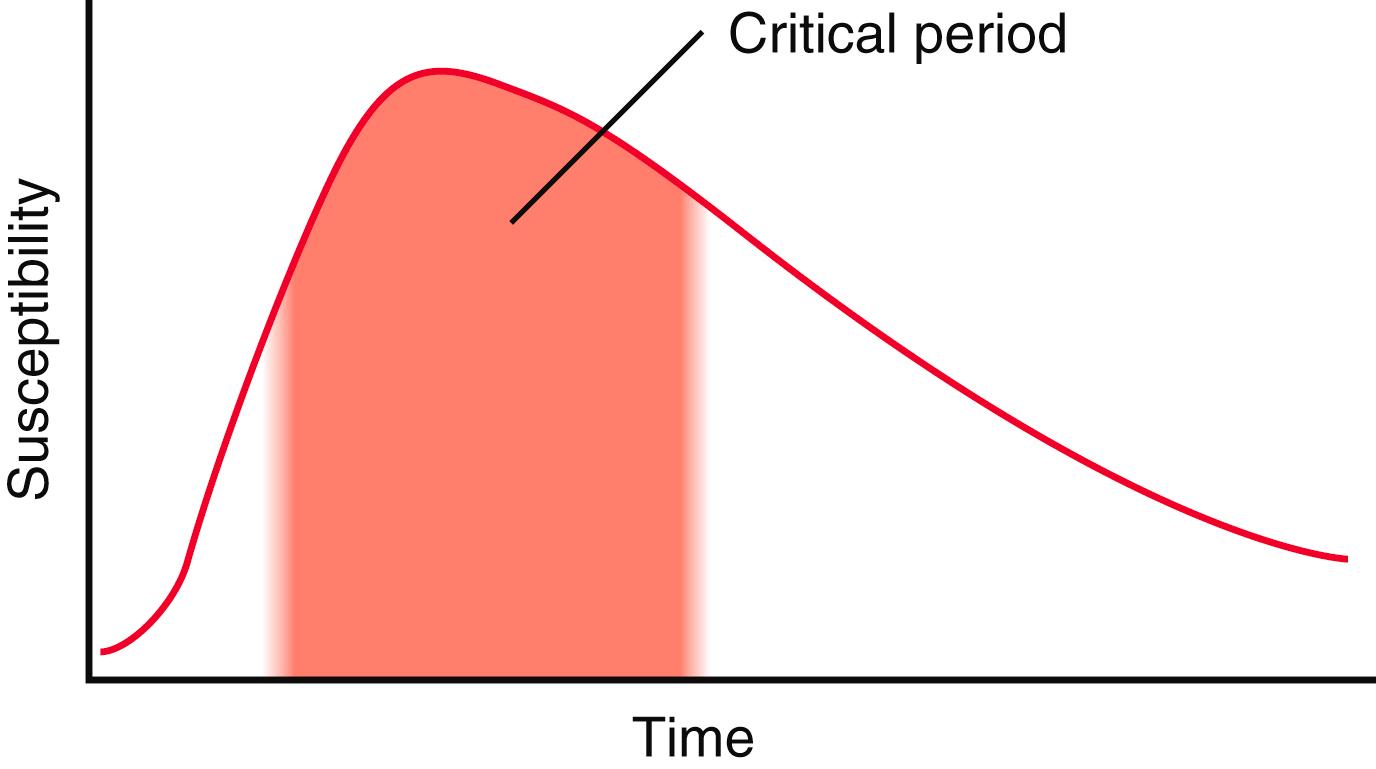
Different organs have different periods of susceptibility during embryogenesis ( Figure 8.7 ). Organs that form the earliest (e.g., heart) tend to be sensitive to the effects of teratogens earlier than organs that form later (e.g., external genitalia). Some very complex organs, especially the brain and major sense organs, show prolonged periods of high susceptibility to disruption of normal development. As an example, the critical period of exposure to thalidomide is from 20 to 36 days of embryonic development. Many interviews of parents of affected children produced the information needed to construct Figure 8.8 , which illustrates the days of exposure to the drug that result in specific malformations.
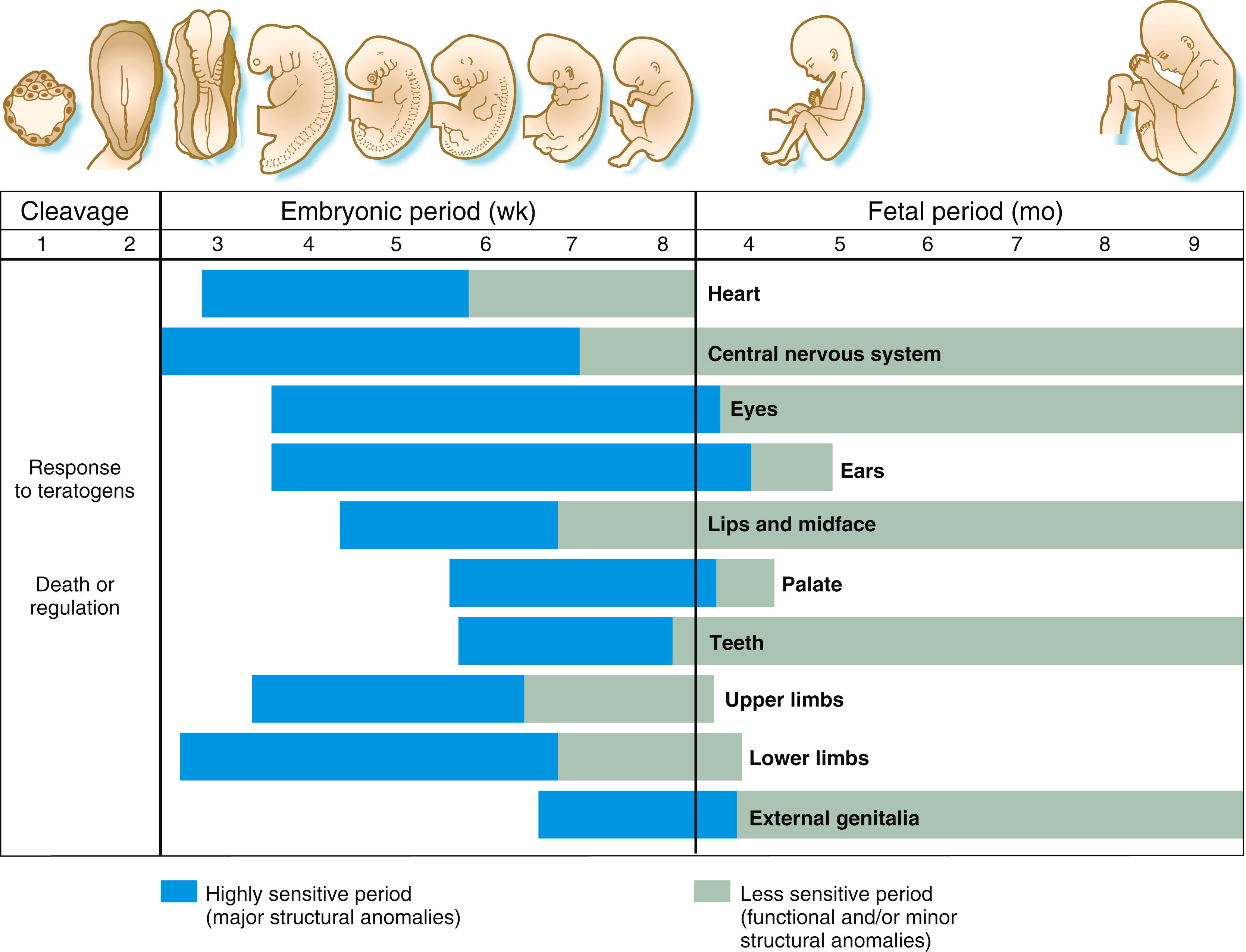
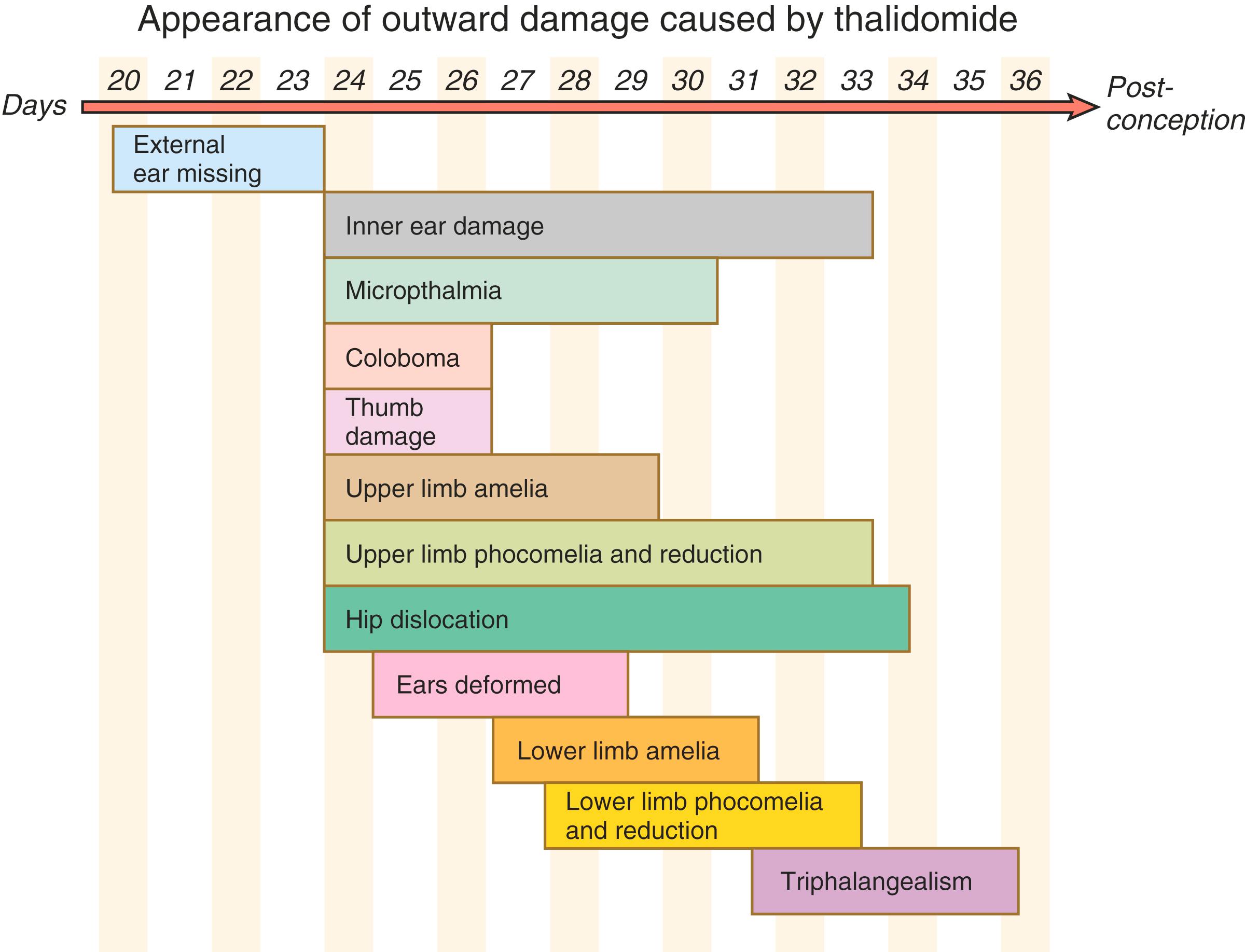
Not all teratogenic influences act in the same developmental periods ( Table 8.3 ). Some influences cause anomalies if the embryo is exposed to them early in development, but they are innocuous at later periods of pregnancy. Others affect only later developmental periods. A good example of the former is thalidomide, which has a very narrow and well-defined danger zone during the embryonic period (20 to 36 days). In contrast, tetracycline, which stains bony structures and teeth, exerts its effects after hard skeletal structures in the fetus have formed.
| Teratogens | Critical Periods (Gestational Days) | Common Malformations |
|---|---|---|
| Rubella virus | 0 to 60 | Cataract or heart malformations |
| 0 to 120+ | Deafness | |
| Thalidomide | 21 to 36 | Reduction defects of limbs |
| Androgenic steroids | Earlier than 90 | Clitoral hypertrophy and labial fusion |
| Later than 90 | Clitoral hypertrophy only | |
| Warfarin (Coumadin) anticoagulants | Earlier than 100 | Nasal hypoplasia |
| Later than 100 | Possible mental retardation | |
| Radioiodine therapy | Later than 65 to 70 | Fetal thyroid deficiency |
| Tetracycline | Later than 120 | Staining of dental enamel in primary teeth |
| Later than 250 | Staining of crowns of permanent teeth |
Although isolated structural or biochemical defects are not rare, it is also common to find multiple abnormalities in the same individual. Several factors can account for this. One possibility is that a single teratogen acted on the primordia of several organs during susceptible periods of development. Another is that a genetic or chromosomal defect spanned genes affecting a variety of structures, or that a single metabolic defect affected different developing structures in different ways.
Despite considerable research since the 1960s, the cause of at least 50% of human congenital malformations remains unknown ( Figure 8.9 ). Roughly 18% of malformations can be attributed to genetic causes (chromosomal defects or mutations based on mendelian genetics), and 7% of malformations are caused by environmental factors, such as physical or chemical teratogens. Of all malformations, 25% are multifactorial, for example, caused by environmental factors acting on genetic susceptibility.
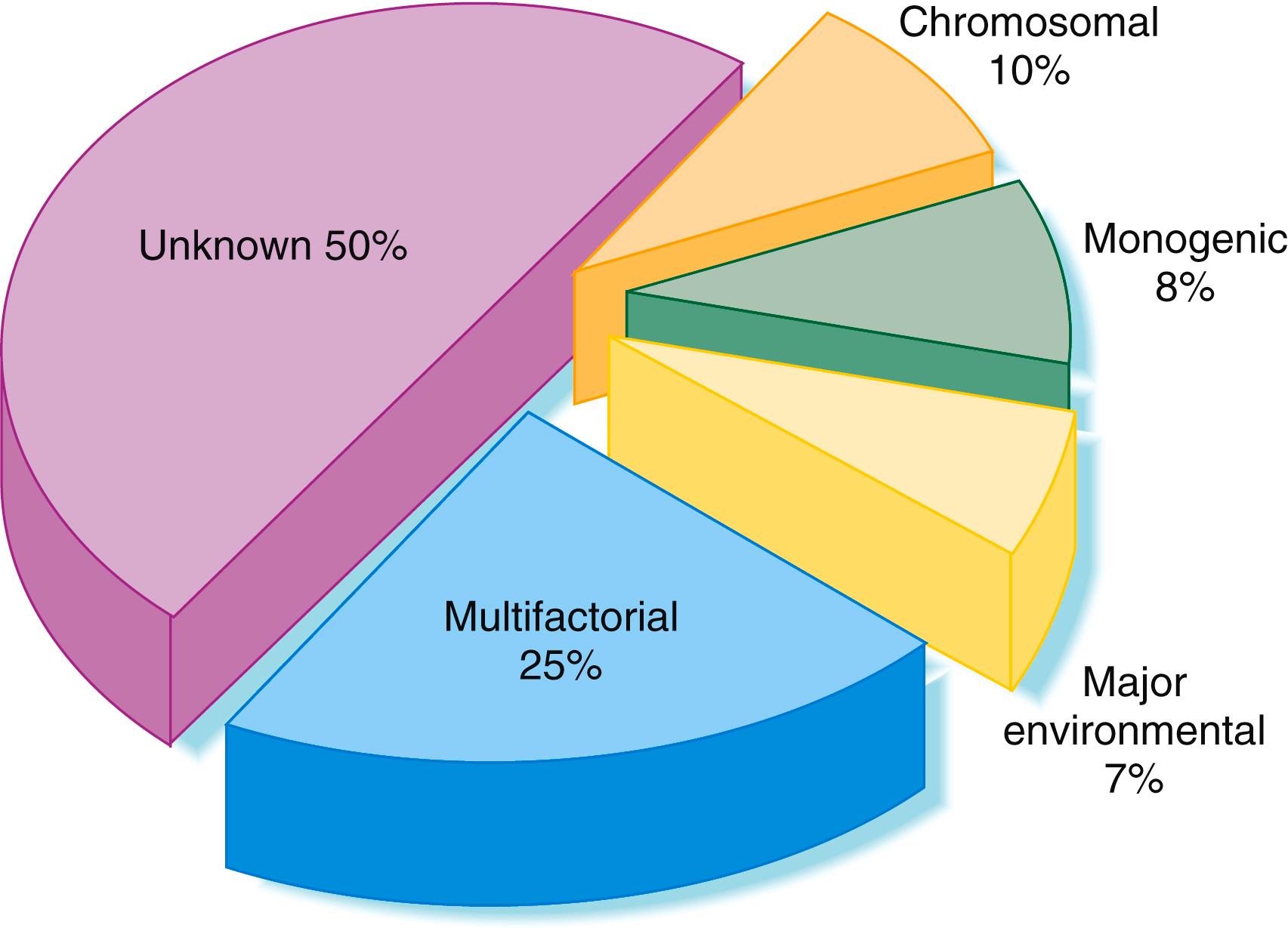
The high percentage of unknown causes is the result of having to work retrospectively to identify the origin of a malformation. Many of these causes are likely to result from some environmental factor influencing the expression of a developmentally critical gene.
Genetically based malformations can be caused by abnormalities of chromosomal division or by mutations of genes. Chromosomal abnormalities are usually classified as structural or numerical errors. These arise during cell division, especially meiosis. Numerical errors of chromosomes result in aneuploidy , defined as a total number of chromosomes other than the normal 46.
Polyploidy is the condition in which the chromosomal number is a higher multiple than two of the haploid number (23) of chromosomes. In most cases, polyploid embryos abort spontaneously early in pregnancy. High percentages of spontaneously aborted fetuses show major chromosomal abnormalities. Polyploidy, especially triploidy, is likely to be caused by either the fertilization of an egg by more than one sperm or the lack of separation of a polar body during meiosis.
Monosomy (the lack of one member of a chromosome pair) and trisomy (a triplet instead of the normal chromosome pair) are typically the result of nondisjunction during meiosis (see Figure 1.7 ). When this happens, one gamete shows monosomy and the other shows trisomy of the same chromosome.
In most cases, embryos with monosomy of the autosomes or sex chromosomes are not viable ( Table 8.4 ). Some individuals with monosomy of the sex chromosomes (45XO genotype) can survive, however ( Figure 8.10 ). Such individuals, who are said to have Turner’s syndrome , exhibit a female phenotype, but the gonads are sterile.
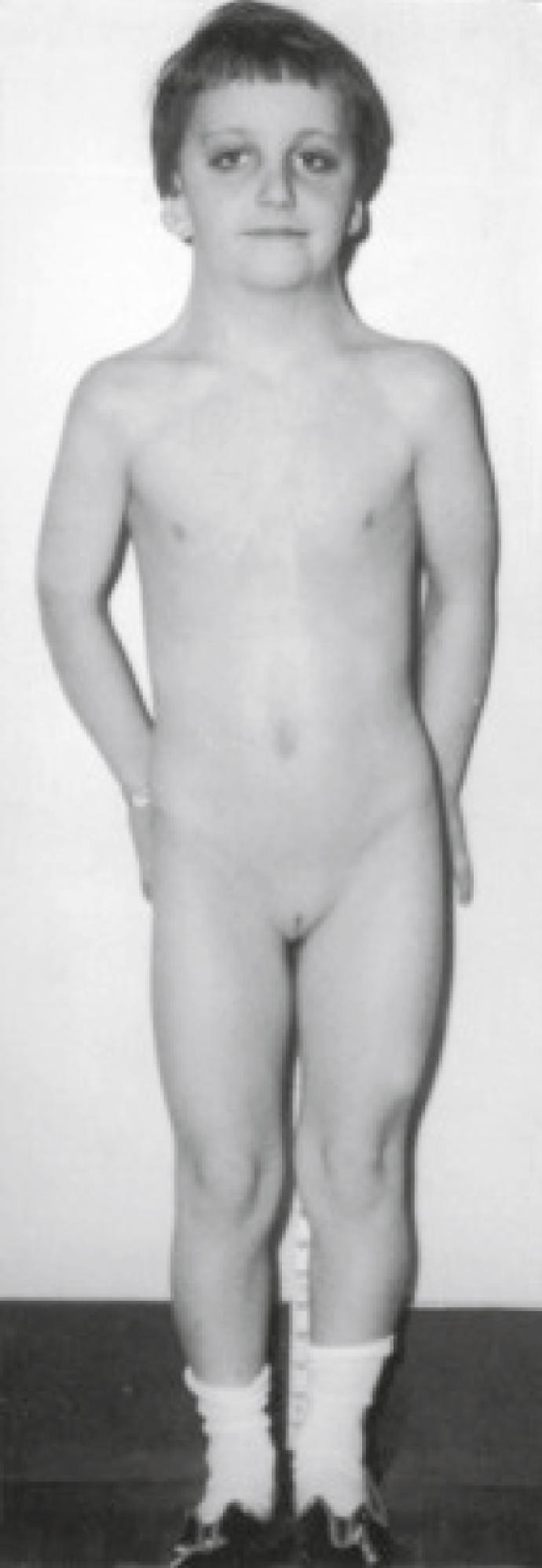
Three autosomal trisomies produce infants with characteristic associations of anomalies. The best known is trisomy 21 , also called Down syndrome . Individuals with Down syndrome are typically mentally retarded and have a characteristic broad face with a flat nasal bridge, wide-set eyes, and prominent epicanthic folds. The hands are also broad, and the palmar surface is marked by a characteristic transverse simian crease ( Figure 8.11 ). Heart defects, especially atrial and ventricular septal defects, are common, with an incidence approaching 50%. Duodenal atresia and other intestinal anomalies are also seen in patients with Down syndrome. Individuals with Down syndrome are prone to the early appearance of Alzheimer’s disease and typically have a shortened life span.
Trisomies of chromosomes 13 and 18 result in severely malformed fetuses, many of which do not survive to birth. Infants with trisomy 13 and trisomy 18 show severe mental retardation and other defects of the central nervous system. Cleft lip and cleft palate are common. Polydactyly is often seen in trisomy 13, and infants with both syndromes exhibit other anomalies of the extremities, such as “ rocker bottom feet ,” meaning a rounding under and protrusion of the heels ( Figure 8.12 ). Most infants born with trisomy 13 or trisomy 18 die within the first 1 or 2 months after birth.
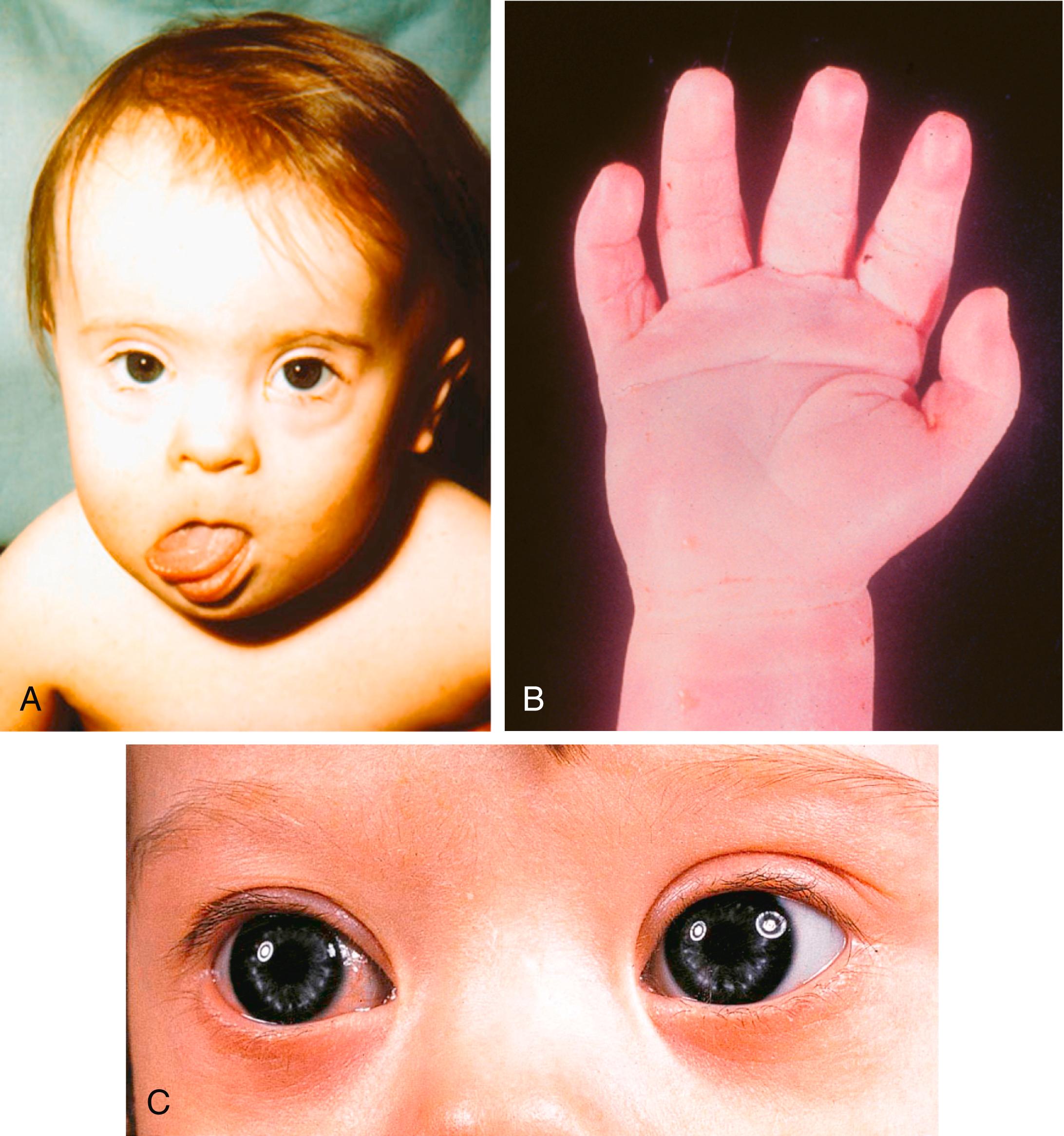
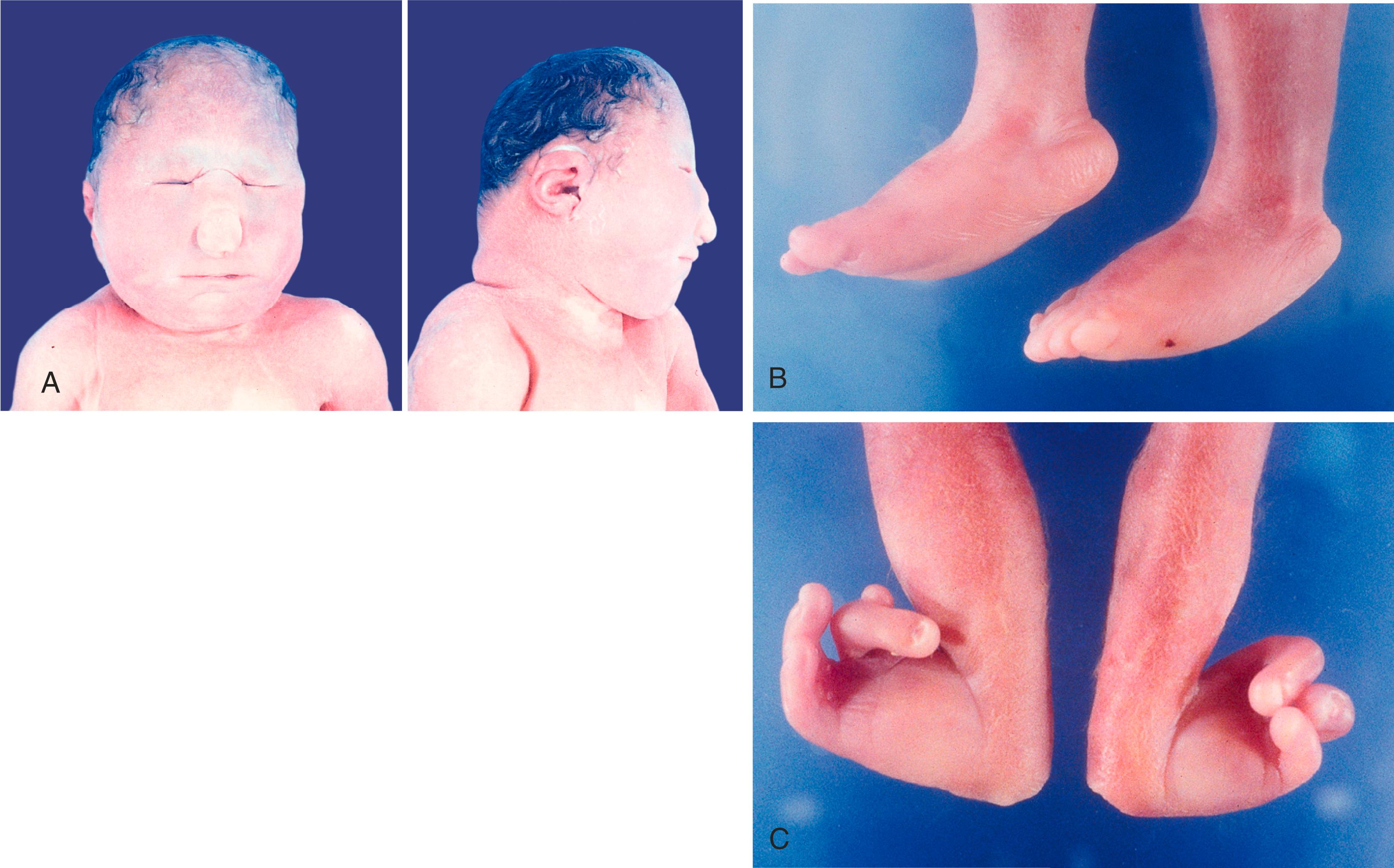
Abnormal numbers of the sex chromosomes are relatively common and can be detected by examination of the sex chromatin (X chromosome) or the fluorescence reactions of the Y chromosomes. Table 8.5 summarizes some of the various types of deletions and duplications of the sex chromosomes.
| Condition | % of Spontaneous Pregnancy Losses |
|---|---|
| Monosomy X (Turner’s) | 98 |
| Trisomy 13 | 95 |
| Trisomy 18 | 95 |
| Trisomy 21 (Down) | 80 |
| Sex Chromosome Complement | Incidence | Phenotype | Clinical Factors |
|---|---|---|---|
| XO | 1:3000 | Immature female | Turner’s syndrome: short stature, webbed neck, high and arched palate (see Figure 8.10 ) |
| XX | Female | Normal | |
| XY | Male | Normal | |
| XXY | 1:1000 | Male | Klinefelter’s syndrome: small testes, infertility, often tall with long limbs ( Figure 8.13 ) |
| XYY | 1:1000 | Male | Tall, healthy appearance; reputed difficulty with impulsive behavior |
| XXX | 1:1000 | Female | Healthy appearance, mental retardation (as many as one-third of cases), fertile (in many cases) |
Various abnormalities of chromosome structure can give rise to malformations in development. Some chromosomal abnormalities result from chromosome breakage induced by environmental factors such as radiation and certain chemical teratogens. This type of structural error is usually unique to a given individual and is not transmitted to succeeding generations.
Other types of structural abnormalities of chromosomes are generated during meiosis and, if present in the germ cells, can be inherited. Common types of errors in chromosome structure are reciprocal translocations, isochromosome formation , and deletions and duplications ( Figure 8.14 ). One well-defined congenital malformation resulting from a deletion in the short arm of chromosome 5 is the cri du chat syndrome . Infants with this syndrome are severely mentally retarded, have microcephaly, and make a cry that sounds like the mewing of a cat.
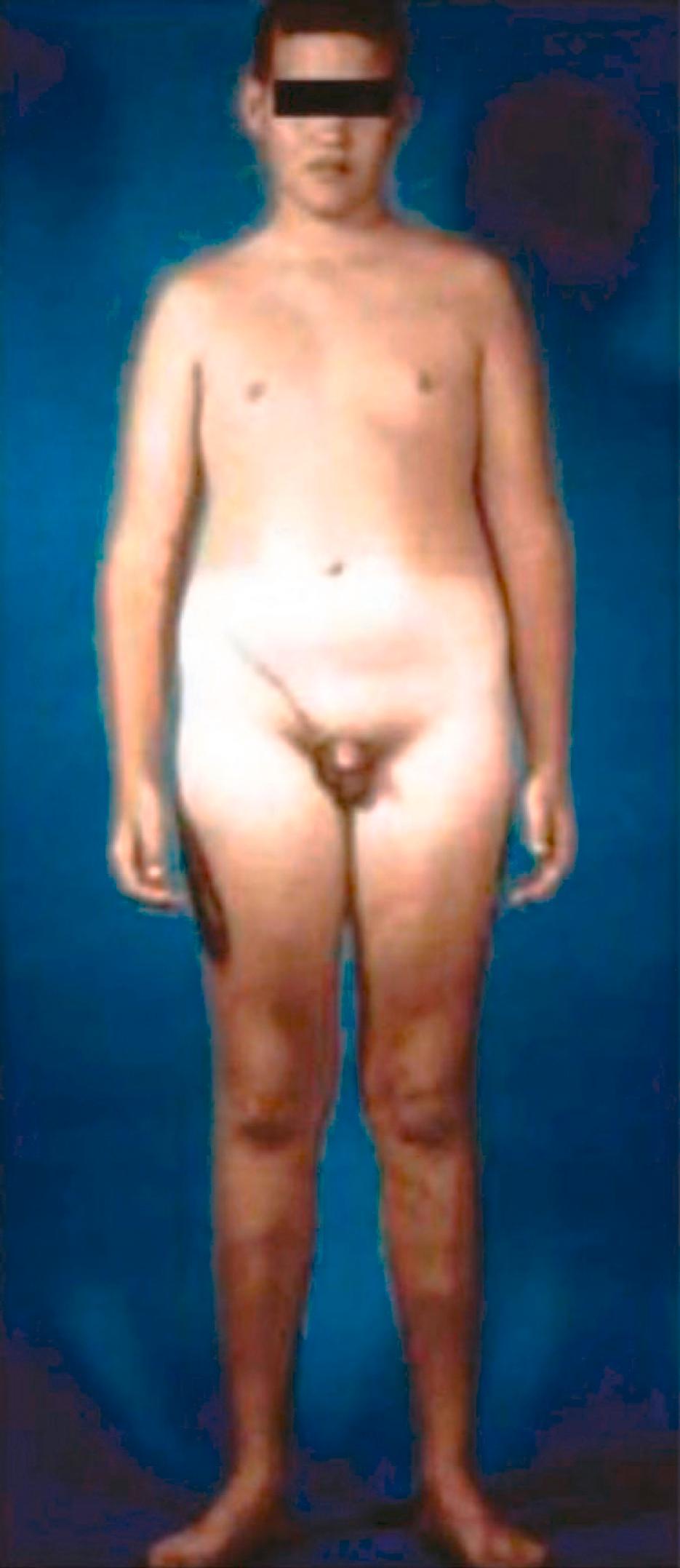
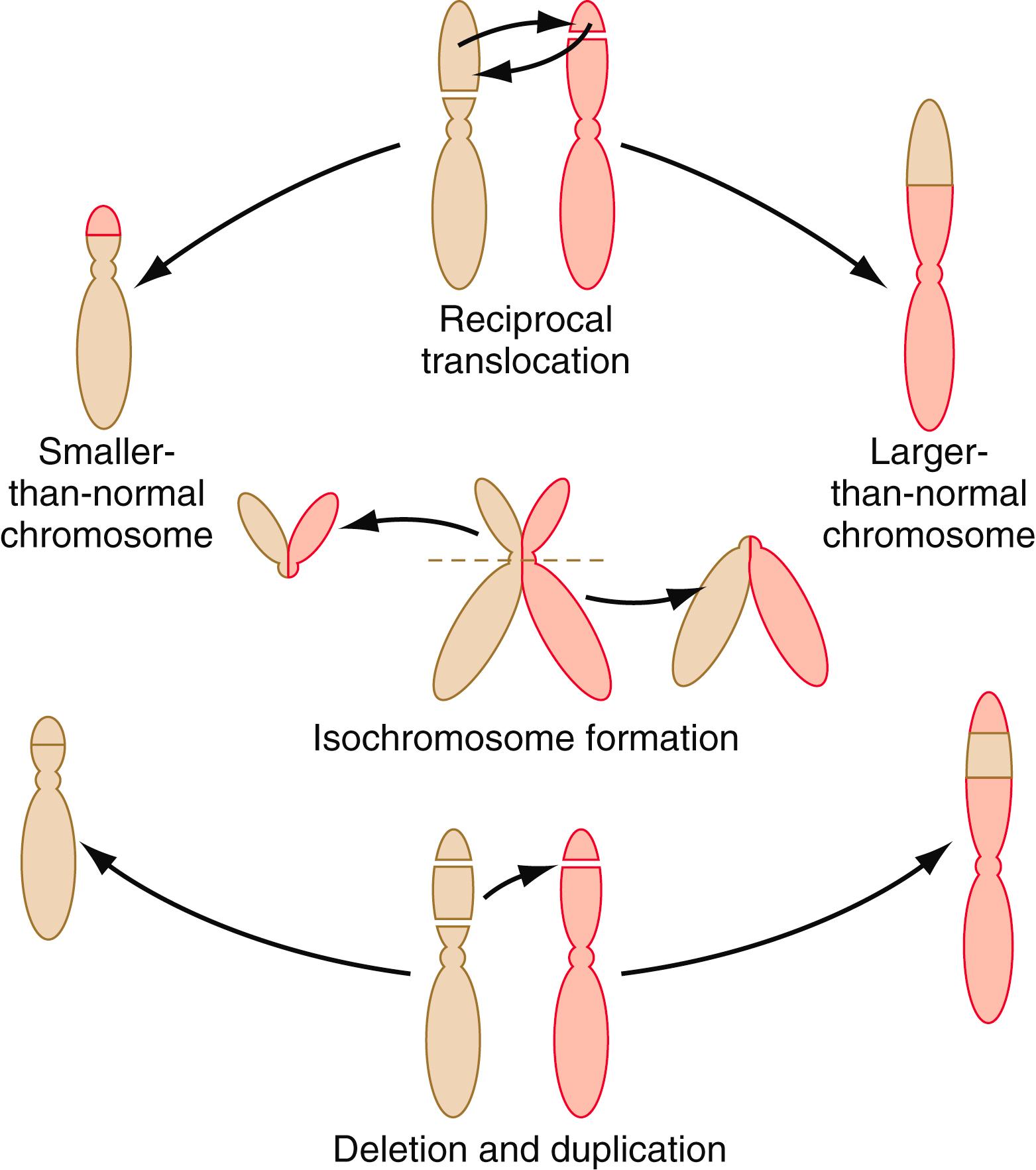
Many genetic mutations are expressed as morphological abnormalities. These mutations can be of dominant or recessive genes of either the autosomes or the sex chromosomes. For some of these conditions (e.g., hemophilia, Lesch-Nyhan syndrome, muscular dystrophy, cystic fibrosis), the molecular or biochemical lesion has been identified, but the manner in which these defects are translated into abnormal development is unclear. Many of these conditions are discussed extensively in textbooks of human genetics, and only representative examples are listed here ( Table 8.6 ).
| Condition | Characteristics |
|---|---|
| Autosomal Dominant | |
| Achondroplasia | Dwarfism caused mainly by shortening of limbs |
| Aniridia | Absence of iris (usually not complete) |
| Crouzon’s syndrome (craniofacial dysostosis) (see Figure 9.36 ) | Premature closure of certain cranial sutures leading to flat face and towering skull |
| Neurofibromatosis | Multiple neural crest–derived tumors on skin, abnormal pigment areas on skin |
| Polycystic kidney disease (adult onset, type III) | Numerous cysts in kidneys |
| Autosomal Recessive | |
| Albinism | Absence of pigmentation |
| Polycystic kidney disease (perinatal type I) (see Figure 16.19 ) | Numerous cysts in kidneys |
| Congenital phocomelia syndrome (see Figure 8.2 ) | Limb deformities |
| X-Linked Recessive | |
| Hemophilia | Defective blood clotting |
| Hydrocephalus (see Figure 11.43 ) | Enlargement of cranium |
| Ichthyosis | Scaly skin |
| Testicular feminization syndrome (see Figure 9.15 ) | Female phenotype caused by inability to respond to testosterone |
Various environmental factors are linked with birth defects. These influences range from chemical teratogens and hormones to maternal infections and nutritional factors. Although the list of suspected teratogenic factors is long, relatively few are unquestionably teratogenic in humans.
Since the recognition in 1941 that rubella was the cause of a spectrum of developmental anomalies, several other maternal diseases have been implicated as direct causes of birth defects. With infectious diseases, it is important to distinguish diseases that cause malformations by interfering with early stages in the development of organs and structures from diseases that interfere by destroying structures already formed. The same pathogenic organism can cause lesions by interference with embryonic processes or by destruction of differentiated tissues, depending on when the organism attacks the embryo. Zika virus, the most recently identified viral teratogen ( Box 8.1 ), acts principally by interfering with the function of neural progenitor cells, but it may also result in the destruction of newly formed brain tissue.
Although it was first discovered in the Zika forest in Uganda in the late 1940s and sporadic outbreaks have occurred periodically since then, Zika virus infections burst upon the contemporary medical scene in March 2015, when an epidemic of the disease, caused by a mutant of the original virus strain, broke out in Brazil. By December of that year, approximately 1.3 million cases were reported, and within a couple more months, more than 4300 cases of microcephaly had been reported in infants born to infected mothers. Zika virus is transmitted to humans via mosquito bites, especially from Aedes aegypti and Aedes albopictus . The virus can also be transmitted from human to human through sexual contact. Common symptoms of the infection are fever, rash, arthritis, conjunctivitis, myalgia, and headache. A serious but relatively rare neurological consequence of a Zika infection is Guillain-Barré syndrome.
Strong evidence links Zika virus infection and microcephaly in infected fetuses. Of 12 genes that are associated with primary microcephaly in humans, 11 are known to be affected by the Zika virus. Disruption of the function of these genes can result in arrest of the cell cycle and apoptosis in neural progenitor cells and later differentiation defects in developing nerve cells. The most sensitive period is the first trimester, but infections occurring later in pregnancy may also result in microcephaly, possibly through destruction of brain tissue. The greatest risk follows infection in the first trimester, but recent reports suggest that microcephaly can even occur in infants infected shortly after birth. A variety of ocular anomalies is also associated with Zika virus infections.
Most infectious diseases that cause birth defects are viral, with toxoplasmosis (caused by the protozoan Toxoplasma gondii ) and syphilis (caused by the spirochete Treponema pallidum ) being notable exceptions. (A summary of the infectious diseases known to cause birth defects in humans is given in Table 8.7 ).
| Infectious Agent | Disease | Congenital Defects |
|---|---|---|
| Viruses | ||
| Rubella virus | German measles | Cataracts, deafness, cardiovascular defects, fetal growth retardation |
| Cytomegalovirus | Cytomegalic inclusion disease | Microcephaly, microphthalmia, cerebral calcification, intrauterine growth retardation |
| Varicella virus | Chickenpox | Microcephaly, chorioretinitis |
| Zika virus | Zika virus | Microcephaly, ocular anomalies |
| Spirochetes | ||
| Treponema pallidum (syphilis) | Syphilis | Dental anomalies, deafness, mental retardation, skin and bone lesions, meningitis |
| Protozoa | ||
| Toxoplasma gondii | Toxoplasmosis | Microcephaly, hydrocephaly, cerebral calcification, microphthalmia, mental retardation, prematurity |
The time of infection is very important in relation to the types of effects on the embryo. Rubella causes a high percentage of malformations during the first trimester, whereas cytomegalovirus infections usually kill the embryo during the first trimester. The agents of syphilis and toxoplasmosis cross the placental barrier during the fetal period and, to a large extent, cause malformations by destroying existing tissues.
Many substances are known to be teratogenic in animals or are associated with birth defects in humans, but convincing evidence that links the substance directly to congenital malformations in humans exists for only a relatively small number ( Table 8.8 ). Testing drugs for teratogenicity is difficult because what can cause a high incidence of severe defects in animal fetuses (e.g., cortisone and cleft palate in mice) may not cause malformations in other species of animals or in humans. Conversely, the classic teratogen thalidomide is highly teratogenic in humans, rabbits, and some primates, but not in commonly used laboratory rodents.
| Agent | Effects |
|---|---|
| Alcohol | Growth and mental retardation, microcephaly, various malformations of face and trunk |
| Androgens | Masculinization of females, accelerated genital development in males |
| Anticoagulants (warfarin, dicumarol) | Skeletal abnormalities; broad hands with short fingers; nasal hypoplasia; anomalies of eye, neck, central nervous system |
| Antithyroid drugs (e.g., propylthiouracil, iodide) | Fetal goiter, hypothyroidism |
| Chemotherapeutic agents (methotrexate, aminopterin) | Variety of major anomalies throughout body |
| Chloroquine deafness | Chorioretinitis |
| Diethylstilbestrol | Cervical and uterine abnormalities |
| Lithium | Heart anomalies |
| Organic mercury | Mental retardation, cerebral atrophy, spasticity, blindness |
| Phenytoin (Dilantin) | Mental retardation, poor growth, microcephaly, dysmorphic face, hypoplasia of digits and nails |
| Isotretinoin (Accutane) | Craniofacial defects, cleft palate, ear and eye deformities, nervous system defects |
| Streptomycin | Hearing loss, auditory nerve damage |
| Tetracycline | Hypoplasia and staining of tooth enamel, staining of bones |
| Thalidomide | Limb defects, ear defects, cardiovascular anomalies |
| Trimethadione and paramethadione | Cleft lip and palate, microcephaly, eye defects, cardiac defects, mental retardation |
| Valproic acid | Neural tube defects |
Previously, folic acid antagonists, which are known to be highly embryolethal, were used in clinical trials as abortifacients (agents causing abortion). Although three fourths of the pregnancies were terminated, almost one-fourth of the embryos that survived to term were severely malformed. A classic example of an embryotoxic folic acid antagonist is aminopterin , which produces multiple severe anomalies such as anencephaly, growth retardation, cleft lip and palate, hydrocephaly, hypoplastic mandible, and low-set ears. These dramatic effects of folic acid antagonists underscore the importance of adequate amounts of folic acid in the diet to promote normal development.
The administration of androgenic hormones to pregnant women either to treat tumors or to prevent threatened abortion resulted in the birth of hundreds of female infants with various degrees of masculinization of the external genitalia. Exposure to elevated androgen levels before 12 weeks can produce clitoral hypertrophy, along with varying amounts of fusion of the genital folds to form a scrotumlike structure ( Figure 8.15 ). Exposure after 12 weeks produces only clitoral hypertrophy because the critical period for formation of the genital folds has already passed.
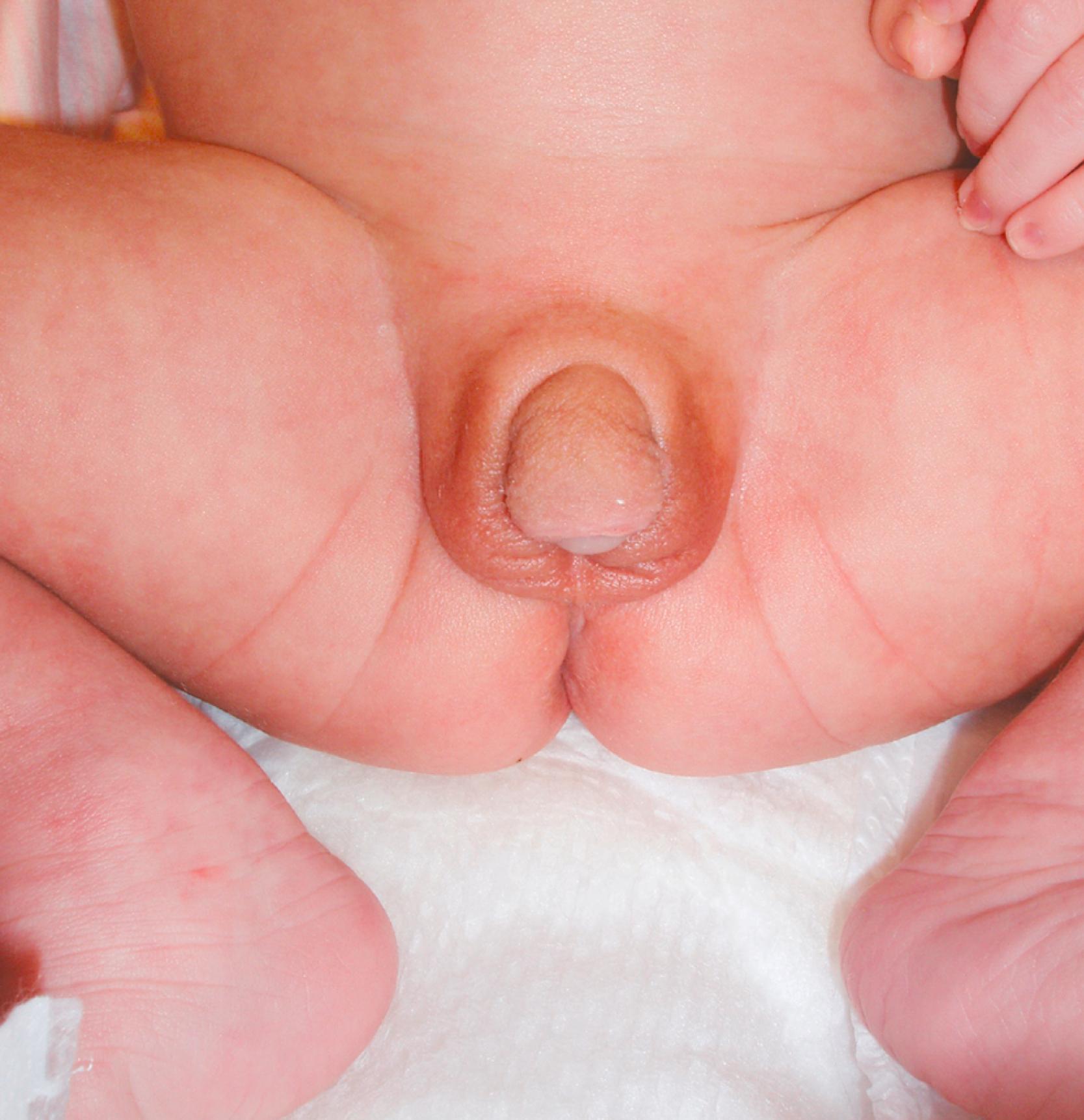
Become a Clinical Tree membership for Full access and enjoy Unlimited articles
If you are a member. Log in here